
Bulletin 11 (VI:1), 1968
Home
Français
Introduction
History
Annual Index
Author &
Subject
Credits
Contact
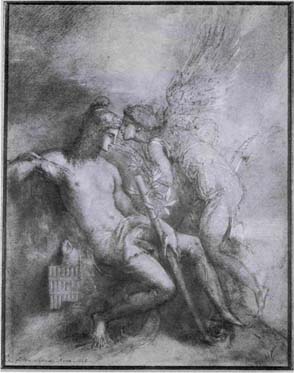
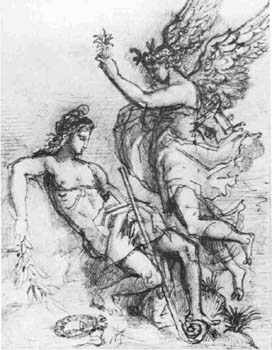

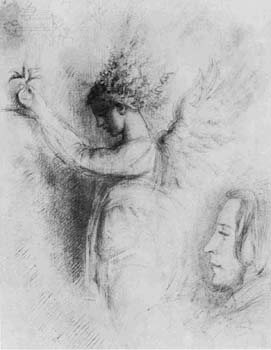

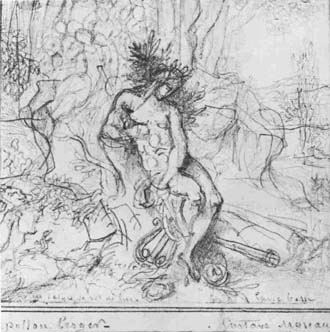
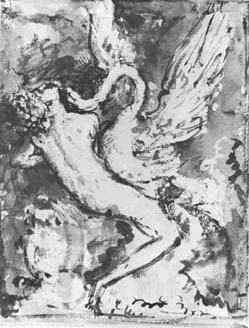
Gustave
Moreau:
Same Drawings from the Italian Sojourn
by Pamela G. Osler, Acting Curator of Prints
The National Gallery of Canada
Résumé en français
Pages 1 | 2
Drawings signed and
dated by the French artist Gustave Moreau (1826-1898) are for the
most part products of his formative years. To this relatively little
known group may be added a drawing done in Rome in 1858 and recently
acquired by the Department of Prints and Drawings under the curious
title Le génie de la musique inspirant le berger Pâris (fig.
1 ). (1) The drawing is highly developed and shows great sensitivity
throughout. In the absence of any known related painting the winged
Muse hovering over the languid figure of a reclining youth appears
to be Moreau's final conception of a compositional theme that had
preoccupied him during his prolonged sojourn in Italy from 1857 to
1859. (2)
Little attention has been given to this trip to Italy made when
Moreau was in his early thirties. Perhaps this is due to lack of
evidence: no letters or notebooks from this period seem to have
survived. We do know something, however, about the artistic climate
in which he worked while in Italy. The numerous copies he made after
frescoes and paintings by Carpaccio, Gozzoli, Mantegna,
Michelangelo, Leonardo and Luini, among others, indicate the
direction in which his interests, stimulated earlier by Chassériau,
continued to move. Occasional references to Moreau in contemporary
letters (3) tell us that he was not unknown to at least some of the
French artists in Italy who attended the Villa Medici or frequented
the Caffè Greco in Rome: Degas, Puvis de Chavannes, Élie Delaunay
and Léon Bonnat. Some of these younger artists may have accompanied
him on his travels to places like Naples, Siena and Venice;
certainly Degas was with him in Florence in the summer of 1858. (4)
It is clear that wide gaps still exist in our knowledge of these
years and of their importance in the maturing of his stylistic
development. Only with the accumulation of documented material and
the eventual grouping of related works may we begin to appreciate
the complexities surrounding Moreau's personality and oeuvre.
Since the acquisition of the National Gallery's sheet, others (figs.
2, 3, 4) definitely related to it have been identified in the Musée
Gustave-Moreau in Paris. Yet another related sheet, inscribed with
the title HÉSIODE ET LA MVSE (fig. 5), (5) is in the
collection of Mr. and Mrs. Germain Seligman in New York. Apart from
the obvious thematic link, three of the drawings (figs. l, 2, 5) have several characteristics in common: they exhibit similar spatial
ambiguities, a Mannerist exaggeration of classicistic forms, and a
strong planarity. Certain features in the handling of pen and pencil
reappear throughout all the drawings in the group: generally, contour
lines exhibit an uneven pressure in the manipulation of the drawing
tool, often being reinforced with additional strokes; modelling is
achieved by the use of soft, broken strokes laid close together to
create shadows; and there is extensive use, particularly in the
later drawings, of parallel lines laid across background and figures,
tending to create a veiled atmosphere.
The order of this small group of drawings is not difficult to
determine. The heavy, angular contours and the tentative rendering
of the figures shown in fig. 2 clearly indicate that this drawing is
the earliest within the group and probably the first version of the
composition, barring the discovery of any other. Next come two
sheets of studies - one from a book, with sketches of a lyre, a branch
of laurel, wings, pipes, and a hand holding a libation bowl (fig.
3), the other a more fully elaborated study of the winged Muse (fig.
4). (6) Then follows the New York sheet (fig. 5), a second larger and
more detailed compositional drawing in which certain transformations
have taken place: the Muse's wings have given way to upward swirling
drapery, her hair is coiled about her head and the position of her
legs is reversed; the male figure now firmly clasps in his left hand
the staff from which grows the laurel branch that formerly hung
listlessly in his other hand, his Phrygian cap is more pronounced,
and in place of the discarded wreath there now appear pipes on the
sloping mountainside. Other minor changes need not be elaborated
upon. The drawing is handled with greater assurance in this second
composition, although neither softened, swelling contours in the
lines of the figures and drapery nor the refined use of pen and
pencil can dispel a certain stiffness. Happily the drawing is dated
1857. Rome, which helps date the three previous drawings to
which it is stylistically linked.
The Ottawa drawing, the fifth in the series, is dated 1858. It is
possible that Moreau did this drawing some time in January or
February of that year since he had already been working out the idea
in 1857. Some details seen in the earlier drawings, such as the
wings, reappear in the later sheet but accessories and landscape
have been reduced to a minimum. Pentimenti, particularly in
the area of the Muse's legs and wings and the lyre, indicate that
Moreau has reworked a second version of the Seligman sheet.
Presumably this is the final version since Moreau has made certain
alterations which strengthen the composition and intensify the
confrontation of the two figures. A more subtle relationship has
been established between the figures: the youth's right forearm is
raised and points in the direction of the Muse as though to signify
recognition, while the Muse, no longer aloof and ceremoniously
holding aloft the lotus blossom, (7) leans forward intimately to
touch the reclining figure with sensitive, outstretched fingers.
The sense of ritual evoked by the earlier drawings has given way
here to a delicate lyricism effected by the fluid line and sfumato.
Since the Seligman drawing is inscribed HÉSIODE ET LA MVSE at
the upper left in the artist's hand, it can only be assumed that the
title of the Ottawa drawing, Le génie de la musique inspirant le
berger Pâris, is incorrect. Even allowing for Moreau's
acknowledged propensity for taking liberties with mythology, it
would be difficult to find an explanation for the subject as
described by the title of the Ottawa sheet. The problem resides in
the figure of Paris, so called no doubt because of the Phrygian cap
he is wearing. The motif of the cap is understandable if the languid
youth is indeed Paris but the presence of the Muse raises doubts
about his identity. The youth fits more logically into the role of
Hesiod or Apollo, both of whom can lay claim to the attributes of
lyre, pipes, staff, laurel branch or wreath, and even the Phrygian
cap. Both are also shown frequently by Moreau to have the same soft
and effeminate appearance {fig. 6), not unlike the figure of Paris
in Raphael's Judgement of Paris, probably known to Moreau
through Raimondi's engraving, to which he may have turned as a
source for the Hesiod image in the group of drawings under
discussion.
While it now seems evident that the theme of the Ottawa drawing is
the inspiration of the poet Hesiod, Moreau's idiosyncratic mind may
have evolved a personal mythology that somehow linked Paris with the
concept of the awakening of creative activity. This may never be
known. In any case one cannot ignore the fact that Moreau created an
iconographical world of his own, peopled by ambiguous figures. The
distinctions between one personality and another are never very
clear-cut. The free association of ideas, set in motion by the
beautiful, vaguely identified but disturbingly alike creatures that
constantly reappear in Moreau's work, weaves a richly imaginative
scene that unfolds sensuously before the spectator. Once lured into
this strangely wonderful atmosphere, where one form and identity
appears to merge into another, it is not surprising that in the
course of looking at the drawings here the mind's eye is seduced by
the suggested relationships between Hesiod and Apollo and other
variations on the theme of creative inspiration, whether poetic or
of a more divine order like Leda and the Swan (fig. 7).
It is possible that Moreau was going through a crisis of some sort
during this sojourn in Italy. For some time prior to his departure
for Rome he had withdrawn from Parisian society, was deeply involved
with the writings of Pascal and appeared to be in a disturbed frame
of mind. (8) Perhaps this group of drawings reflects the evolution of
this psychic state. Moreau's preoccupation with the theme of the inspiration of
the poet, and the progression from the awkwardness and stiffness of
the early drawings of this subject to the lyricism of the final one
might suggest a period of doubt and groping in his creative
development, followed by a growing self-awareness. This suggestion
is further hinted at by a gradual and subtle transformation in the
nature of "la belle inertie," that quality characteristic
of all Moreau's overly refined figures. In the first drawing (fig.
2) Hesiod's right arm hangs listlessly, the laurel branch droops,
the wreath lies discarded on the ground and there is no contact
between the totally passive Hesiod and the Muse. The Seligman
drawing shows signs of life in the flowering staff and in the figure
of the Muse who has retrieved the wreath. Finally, within the
dream-like atmosphere of the Ottawa drawing there is a sense of
mounting tension in the suspended interaction between Hesiod on the
verge of awakening and the Muse emerging chrysalis-like as a
creative force.
Next Page | Notes
1 | 2
Annual Index | Author & Subject | Credits | Contact
This digital collection
was produced under contract to Canada's Digital Collections program,
Industry Canada.
"Digital
Collections Program, Copyright
© National Gallery of
Canada 2001"